HOW GENES ARE INHERITED: The Dilemmas of Huntington’s Disease and The Work of Gregor Mendel.
About eight people in every 100, 000 are born
with the genetic disorder Huntington’s disease. This condition, which involves
premature degeneration of the brain, is caused by a single faulty gene on
chromosome 4. The slow decline into dementia that develops is fatal.
Diagnosis is difficult because early symptoms are vague: sufferers can have bursts of temper, become more clumsy than usual or have difficulty remembering things. Also, the symptoms do not usually become apparent until the sufferer is in their 30s or 40s, usually after they have passed the gene on to the next generation.
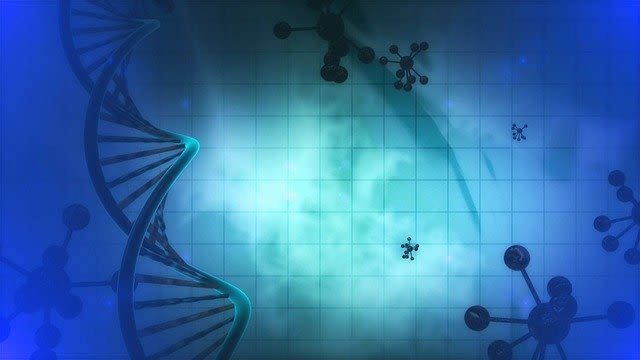
Image by PublicDomainPictures from Pixabay
Until recently, people with a family history of the disease knew that they were at risk, but they could never be sure whether they were actually carrying the gene. This led to a dreadful dilemma: should they go ahead and have children and risk passing the gene on, or should they decide to remain childless, only later to experience the anguish of finding out that they were free of Huntington’s disease when it was too late to try for a baby?
Today, tests are available that can tell people whether they are carriers of the Huntington’s gene. A sample of DNA can even show if an unborn baby carries the disease. This does not make the decisions involved any easier, but it does give affected families accurate information on which to base those decisions.
Woody Guthrie, the famous American folk singer, suffered from Huntington’s disease. His son, Arlo, was born before his father knew he had a disease that could be passed on to his children. Luckily, Arlo is unaffected: he has not inherited his father’s faulty gene.
The degeneration caused by Huntington’s disease can be revealed by a brain scan. A protein called huntingtin, produced by a faulty gene that was discovered in 1993, damages nerve cells in some areas of the brain, including the cerebral cortex. The gene persists because affected people tend to reproduce before symptoms appear.
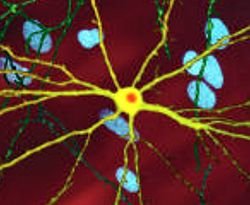
A quick reminder on what a gene is: It is a length of DNA that acts as a template for the production of messenger RNA. mRNA forms a mobile copy of a gene, travelling from the cell’s nucleus to the cytoplasm.
MENDELIAN INHERITANCE
Why don’t we look exactly like our parents? Why are brothers and sisters all different (unless identical twins) when born to the same parents? There is often a marked family resemblance between parents and their children and between siblings. However, all new-born babies, except identical twins, are genetically unique. Every new-born baby has around 30 000 genes and because humans – like most animals – are diploid organisms, a baby has two versions of each gene. It inherits one version from its mother and one version from its father.
It is difficult to imagine what happens when 30 000 different genes are mixed. Not surprisingly, although a vast amount of genetics research is under way, we are still a long way from completely understanding what happens when those mixed genes are passed on to the next generation. Some genes are activated, while others remain hidden, some master genes switch on whole blocks of other genes.
How can we begin to make sense of it all? Amazingly, the man who first worked out the underlying rules did so without any knowledge of genes, chromosomes, DNA or cell division. Known as the father of genetics, Gregor Mendel worked with pea plants. These are much simpler organisms than humans and provide a good starting point to understand some of the basic rules of Mendelian inheritance.
THE WORK OF GREGOR MENDEL
Gregor Mendel, A Czech monk, was the first to work out the basic laws that govern the inheritance of genes. Before Mendel’s work became known, it was widely thought that inheritance was due to ‘blending’ of different features. So, for example, a tall person married to a short person would produce children who would eventually grow to an intermediate height. Mendel showed it was wrong to assume that characteristics blended and demonstrated how individual characteristics are passed down to the next generation.
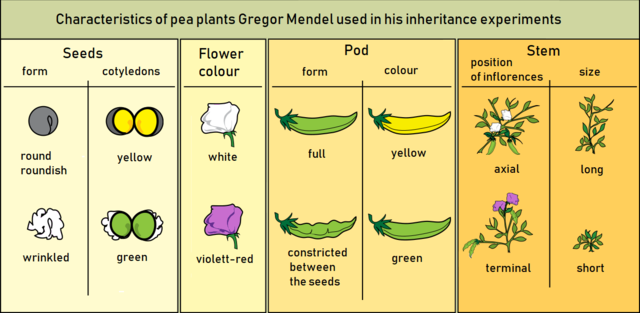
Characteristics Mendel used in his experiments. LadyofHats, CC0
For years, Mendel bred and studied the edible pea plant. He chose these plants because they had easily observable features, they were easy to cultivate, they had rapid life cycles and their pollination could be controlled. His breeding experiments centred on the inheritance of a few features such as plant height, flower colour and pea shape/appearance.
Mendel was lucky because he chose features that were controlled by single genes. In addition, pea plants tend to fertilize themselves and produce pure breeding homozygous individuals. Had Mendel worked with more complex features or a different species, he might not have been able to work out the underlying laws of inheritance.
Mendel conducted his experiments using a good scientific method. He controlled his experimental conditions carefully, ensuring that plants were pollinated only by the pollen he transferred. He made careful observations and then repeated experiments as many times as was practicable, keeping meticulous records. Mendel was trained in mathematics and he applied statistical methods to his results in a way that was very advanced for the time.
His genius really showed in the way he interpreted his results. Mendel proposed the particulate theory, in which he stated that there are individual units of heredity that cannot be diluted, only hidden. Mendel came up with the idea that each pea plant has two factors for each character. One inherited from each parent. Only one unit can be present in the gamete and so be passed on to the next generation. Mendel’s ‘particles’ are, of course, genes.
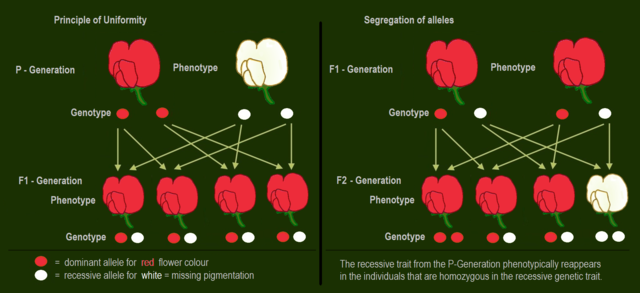
Dominant-recessive inheritance - flowers of pea plants. Sciencia58, CC0
In 1866, Mendel published a detailed account of his findings, but their significance was not appreciated by the scientific community. In 1884, Mendel died without ever receiving true recognition for his work. In 1900, his work re-emerged thanks to the independent work of three other European scientists. In the time between 1866 and 1900, the process of meiosis had been discovered and this provided a mechanism that would explain Mendel’s observations. All three scientists cited Mendel’s original work, which had suggested the basic mechanism of inheritance.
Meiosis and Mendel’s findings
Mendel’s findings can be summarized into two laws, both of which are explained by the process of meiosis.
- Mendel’s law of segregation states:
An organism’s characteristics are determined by internal factors that occur in pairs, only one of which can be present in a single gamete.
In other words, an organism has two versions of each gene, but only one of these version is passed on to the offspring. This is because meiosis separates homologous pairs of chromosomes, so that only one of each pair passes into the gamete.
- Mendel’s law of independent assortment states:
Each of a pair of contrasted characteristics can be combined with each of another pair.
Again, this is explained by meiosis; any one of a pair of chromosomes can pass into the gamete with any member of another pair. The significance of this is seen in dihybrid (two-gene) inheritance.
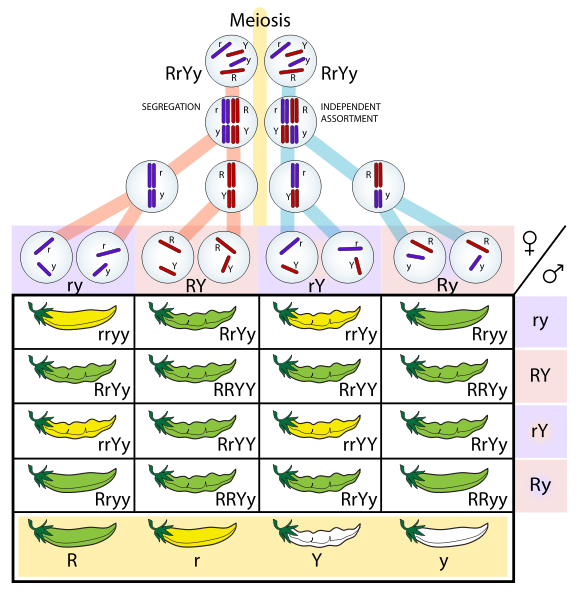
Mendel’s second law is perhaps easier to understand by considering an example. If you have a plant with red or white flowers and round or wrinkled seeds, the offspring can have any combination of flowers and seeds; red and round, red and wrinkled, etc. The offspring will not necessarily have the same combination as the parent.
MONOHYBRID INHERITANCE: HOW SINGLE GENES ARE PASSED ON
Monohybrid (single-gene) inheritance concerns the inheritance of different alleles (usually two) of a single gene. Like Mendel, we start with the pea plant. Peas have several easily observable features that are controlled by single genes. For example, pea plants have one gene for height. The height gene has two alleles: tall (T) and dwarf (t). Pea plants are diploid and so have two alleles. There are therefore three possible genotypes:
TT – homozygous for T (homo = same)
Tt – heterozygous (hetero = different)
tt – homozygous for t
In genetics, different alleles are often denoted by letters, such as Aa. Usually, the capital letter stands for the dominant allele. As a tip, if you are choosing letters to represent alleles, choose those whose capital cannot be confused with the lower case version. So, Rr is better than Ss.
Homozygous individuals are said to be true breeding. This means that they will always produce the same phenotype of offspring because they are not hiding a recessive allele.
Consider what happens when a homozygous tall plant is crossed with a homozygous dwarf plant. All the gametes from the tall plant contain a T allele and all those from the dwarf plant have a t allele. These combine at fertilization to give offspring all with the genotype Tt. The first generation, known as the F1, are all tall. Because tallness is dominant. However, although they look identical to the tall parent plant, they are different in one very important respect: they are heterozygous and not homozygous.
If two of these heterozygous plants are crossed, half of the gametes from each parent are T and half are t. Giving us four possible genotypes in the second generation, the F2:
25% are TT, 25% are tT, 25% are Tt, 25% are tt
The first three genotypes give tall plants (the T allele is present) but a quarter of the plants are dwarf (they are homozygous for the t allele).
It is important to realize that chance plays a very important part in genetics. If I took four F2 pea plants we might expect to get three tall plants and one dwarf, but it is highly likely that we would get something else, such as four and none or two and two. The greater the number of offspring, the higher the chance that the numbers reflect the expected ratio. This is why Mendel had to carry out hundreds of crosses before he became convinced of the underlying ratio.
The test cross
It is often important to know whether an individual displaying a dominant trait is homozygous or heterozygous for a particular allele. For example, how can we tell if a tall pea plant is pure breeding, or if it is carrying a hidden dwarf allele? To find out we do a test cross. This involves crossing the tall plant with a homozygous dwarf plant (tt). If the tall plant is homozygous (TT). All the offspring produced are tall. However, if it is a heterozygote (Tt), about half the offspring are tall and half are dwarf.
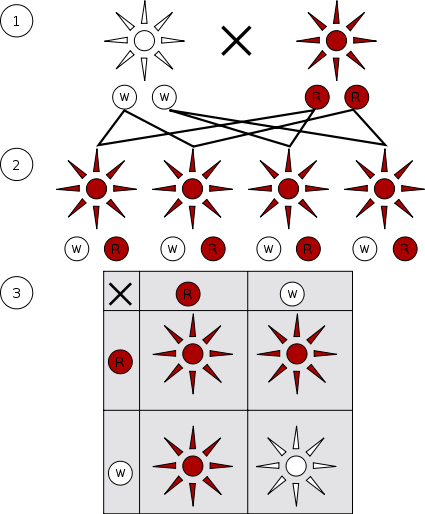
MONOHYBRID INHERITANCE IN HUMANS
Clear-cut examples of monohybrid inheritance in humans are relatively rare, and often involve genetic disease where people inherit one or more faulty alleles. Genetic diseases are often recessive because faulty alleles that fail to make an important protein can be masked by normal ones that function properly. The table below shows examples of monohybrid inheritance in humans. Also, the ability to roll the tongue is often cited as a simple example of inheritance in humans. However, although people seem to fall neatly into one of two categories – either you can roll your tongue or you can’t – there is considerable debate about whether or not this skill can be learned, and whether it is controlled by one gene or more.
In contrast, some genetic disorders such as Huntington’s disease are caused by dominant alleles. The alleles concerned code for a product that actively causes damage; the symptoms are not due to an allele not doing its job. Such alleles are dominant because the presence of a normal allele cannot mask the symptoms.
EXAMPLES OF MONOHYBRID INHERITANCE IN HUMANS
| Traits | Features |
| Dominant traits | |
| Huntington’s disease | explained in the first paragraph of this post |
| Freckles | |
| Dimple in chin | |
| Recessive traits | |
Sickle cell anaemia | Haemoglobin polymerizes, distorting red blood cells into a sickle shape. This leads to circulatory blockages and anaemia. |
| Attached ear lobes | |
Phenylketonuria (PKU) | Inability to process the amino acid phenylalanine. Protein intake must be monitored to prevent build-up of the amino acid to harmful concentrations. It can be fatal if not treated. |
| Haemophilia (also sex linked ) | Inability to produce a critical blood-clotting factor, carried on the X chromosome. Haemophilia is now treated by supplying the affected individuals with the clotting factor. |
| Albinism | Inability to make the pigment melanin |
| Rhesus blood group | Presence (Rh+) or absence (Rh-) of rhesus protein on red blood cells |
Cystic fibrosis | Excessive mucus production, especially in lungs and pancreas. Breathing and digestion are affected and sufferers are very susceptible to lung infections |
| Galactosaemia | Inability to convert galactose to glucose in the liver. All lactose must be avoided to prevent fatal levels of galactose from accumulating. |
| Tay-Sachs disease | Inability to produce critical lipases, which results in fatty accumulations in the brain |
| Lactose intolerance | Inability to breakdown the disaccharide lactose to glucose and galactose. Leads to vomiting, diarrhoea, flatulence. Avoiding lactose prevents symptoms |
Inbreeding and outbreeding
Everyone agrees that brothers and sisters or other closely related people should not have children. In most human societies such inbreeding is illegal for social, moral and biological reasons. Biologically, inbreeding is undesirable because it reduces genetic variation in the offspring. Inbreeding promotes homozygosity: inbred individuals are homozygous for many more alleles than individuals produced by outbreeding, So, faulty recessive alleles are more likely to be paired up, resulting in a much higher proportion of genetic defects and disease.
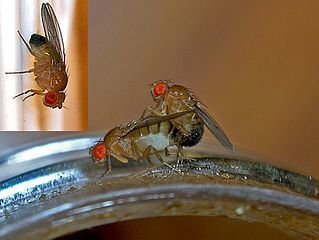
In practice, inbreeding tends to happen in small, isolated human and animal populations, or as a consequence of artificial selection. Pedigree dog and cat breeding is a good example of this. To maintain the most desirable features, champion animals are often bred with near relatives. Analysis of the pedigree certificates of the champions in a particular breed will often show that the same individuals crop up again and again. The consequence of this artificial selection is a relatively high proportion of genetic defects.
Outbreeding (the breeding of unrelated individuals) is more desirable as it produces more new genetic combinations and greatly reduces the chance that faulty genes will be expressed. Many organisms have developed mechanisms which prevent inbreeding. If pedigree animals are cross-bred, rather than inbred (cross a Siamese cat with a Persian, for example), you often get a fitter, healthier animal. We say that such offspring show hybrid vigour, and cross-breeding is a favourite tool of plant breeders who find that hybrids often grow faster and show better disease resistance.
In my next post, I will discuss the Cystic fibrosis: an example of monohybrid inheritance in human, dihybrid inheritance: how two genes are passed on and finally on when Mendel’s laws don’t apply.
Thanks for reading.
REFERENCES
https://en.wikipedia.org/wiki/Huntington%27s_disease
https://ghr.nlm.nih.gov/condition/huntington-disease
https://hdsa.org/what-is-hd/overview-of-huntingtons-disease/
https://jamanetwork.com/journals/jama/fullarticle/197209
https://en.wikipedia.org/wiki/Mendelian_inheritance
https://en.wikipedia.org/wiki/Gregor_Mendel
http://www.dnaftb.org/1/bio.html
https://education.seattlepi.com/explanation-mendels-three-laws-through-discussion-meiosis-3838.html
https://www.britannica.com/science/heredity-genetics/During-meiosis
http://www.nature.com/scitable/topicpage/mitosis-meiosis-and-inheritance-476
https://courses.lumenlearning.com/boundless-biology/chapter/laws-of-inheritance/
https://biologydictionary.net/test-cross/
https://en.wikipedia.org/wiki/Test_cross
https://en.wikipedia.org/wiki/Monohybrid_cross
This post has been voted on by the SteemSTEM curation team and voting trail. It is elligible for support from @curie and @minnowbooster.
If you appreciate the work we are doing, then consider supporting our witness @stem.witness. Additional witness support to the curie witness would be appreciated as well.
For additional information please join us on the SteemSTEM discord and to get to know the rest of the community!
Thanks for having used the steemstem.io app and included @steemstem in the list of beneficiaries of this post. This granted you a stronger support from SteemSTEM.
Wow, wow, wow!
This session was so educative and enlightening. I am interested in genetics and microbiology as well. I just realized you are Nigerian. Mek we chat more na, e get plenty procedures I for like learn from you. 😁
Thanks for coming, @benditofrancis.
Yes, I'm a Nigerian. We can chat on discord. I'm @loveforlove#5149